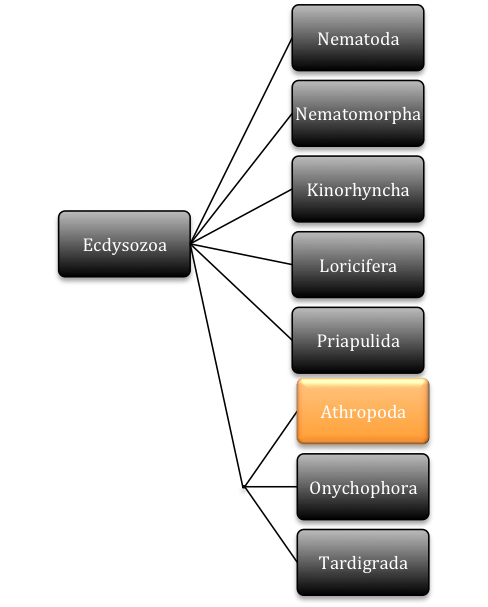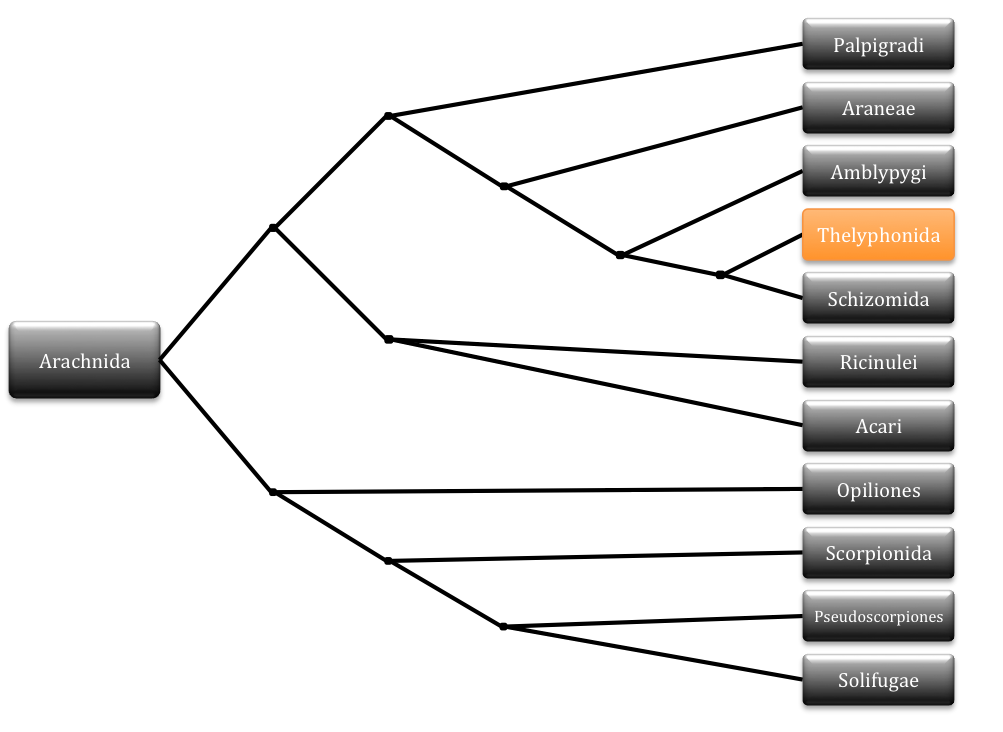Classification
Mastigoproctus giganteus
Taxonomy
Domain Eukarya
Kingdom Animalia
Phylum Arthropoda
Class Arachnida
Order Thelyphonida
Family Thelyphonidae
Genus Mastigoproctus
Species Mastigoproctus
giganteus
Domain Eukarya
Mastigoporctus giganteus
falls under this domain because its cells possess a nucleus and
membrane bound organelles.
Kingdom Animalia
M. giganteus belongs to Kingdom Animalia for several
reasons. Like all animals, it is heterotrophic, meaning it gains
its nutrients by consuming other organisms. Unlike fellow
opisthokonts in Kingdom Fungi, animals like M. giganteus
ingest food before digesting it. M. giganteus also is
motile and reproduces sexually, which are other traits that
unite animals as a kingdom.


Figure 1. Phylogenetic tree showing the extant phyla that belong to the monophyletic group of Ecdysozoa, which contains molting animals. The second tree shows the classes that belong to Phylum Athropoda under the Subphyla Myriapoda and Chlicerata. The orange shows which group M. giganteus belongs to (Tree of Life Web Project 2002).
Phylum Arthropoda
M. giganteus is placed under Phylum Arthropoda because it
possesses a hardened cuticle that makes up its exoskeleton, jointed
legs, and a clearly segmented body (Budd and Telford 2009). To learn
more about Arthropods, check out these other students' pages for the
Crane Fly,
Tipula submaculata or the Flathead Lobster,
Thenus orientalis.
Class Arachnida
Like all members of this class, M. giganteus have eight
legs, modified mouthparts, and their body is divided into two
regions called the cephalothorax and abdomen (Zipcode Zoo 2013).
Take a look at these other students' pages to learn about other
Arachnids, like the spiders,
Salticus scenicus or
Centruroides sculpturatus, or the Deer Tick,
Ixodes scapularis.
Order Thelyphonida
This order formerly was known to scientists as Order Uropygi, but
recently has been changed to the name Thelyphonida. Unlike some
other arachnids, members of this order do not possess a silk gland
or any type of venom. M. giganteus also possesses all the
traits of this order, which include its whip-like tail, and the
secretion of acetic acid as a defense mechanism (Ohio State
University 2011).
Figure 2. Phylogenetic tree showing the extant orders that belong to Class Arachnida. Order Thelyphonida is the order that contains M. giganteus. (Tree of Life Web Project 2002).
Family Thelyphonidae
This family is the single family that belongs to Order Thelyphonida
(thus the similar names) and possesses all the same traits.
Organisms belonging to this family are commonly known as
whipscorpions or vinegaroons. M. giganteus fits into this
family because of its acetic acid chemical defenses, whip-like tail
and enlarged pedipalps (Harvey 2003).
Genus Mastigoproctus
M. giganteus belongs to this genus because it is among the
whipscorpions that are local to North and South America.
Species Mastigoproctus giganteus
M. giganteus was discovered by Lucas in 1835 (Kern and
Mitchell 2011). Translated from Latin, Mastigoproctus giganteus
means gigantic whip proctor. As this name suggests, M. giganteus
is larger than the rest of the members of Genus Mastigoproctus.
To view various trees at any point in evolutionary history check out the very useful website Tree of Life Web Project.
Continue to Habitat and Geography
Return to Home
See References
